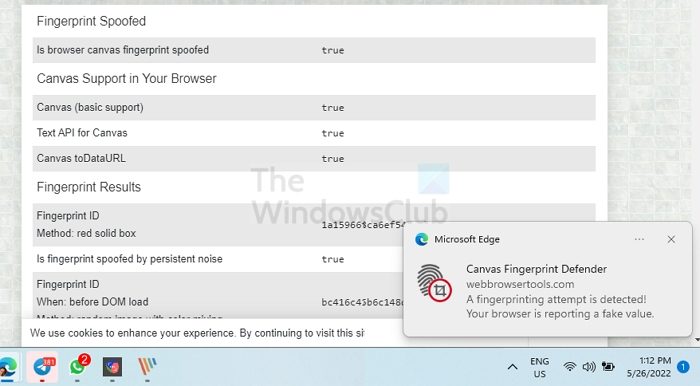While Cookies and other means have been used to track online users for quite a time now. A new tracking mechanism was developed. This mechanism uses the HTML 5 Canvas Element to track visitors, and it is called Canvas Fingerprinting. But since privacy is the most important security aspect these days, you need to make sure that your browser is canvas fingerprinting proof.
We’ve already talked about how to block canvas Fingerprinting in Firefox. In this post, we’ve discussed Canvas Fingerprinting in detail and covered a free Chrome extension, ‘Canvas Defender’, that lets you protect your device’s fingerprint.
What is Canvas Fingerprinting
Canvas Fingerprinting is a technique that records your computer’s fingerprint-based on your graphics hardware. These fingerprints can be shared by websites, essentially tracking your usage on the internet. Advertising companies widely use these fingerprints or digital tokens to feed you personalized advertisements and track your behavior.
While you visit a website with canvas fingerprinting enabled, your browser is instructed to draw hidden graphics. Now, these rendered graphics can contain information about the type of your system, OS, GPU, and Graphics Driver. All these details combined with some other information generate your unique fingerprint. Although the uniqueness is not so good when combined with other fingerprint methods the desired amount of entropy and uniqueness can be achieved.
Read Browser Fingerprinting and Online Privacy.
Prevent Canvas Fingerprinting on Google Chrome
Using an extension called Canvas Defender, one can prevent Canvas Fingerprinting on your browser. The thing that is special about this extension is that instead of completely blocking Canvas Fingerprinting, it hides your original fingerprint and replaces it with spoof data.

To see this tool in action, you can go to browserleaks.com/canvas and check your browser’s current uniqueness and signature. The browser will automatically generate the noise and the browser will report a fake value every time it detects canvas fingerprinting on a website.
It is recommended to generate a new fingerprint from time to time always to protect your identity. Also, the extension can notify you whenever a web page tries to get your identity from the Canvas. These notifications can get annoying soon, and there is no option to disable them for now.
Moreover, the tool can work both in normal and incognito mode and completely guard against fingerprinting. You can even maintain a whitelist for websites that you want to work generally with your original fingerprint. Also, you can set up a time interval after which the fingerprint will automatically be changed. It has a wide variety of options starting from 5 minutes to a week.
Canvas Defender is a must-have Chrome extension. It can silently protect you from Canvas Fingerprinting by generating a false signature. Unlike other fingerprint blocking applications, this extension will not completely block fingerprints on your browser. Blocking fingerprints is another identifier for websites, and you’ve installed some blocking software. So instead of blocking, this extension can hide your identity in a completely safe manner.
Does a VPN prevent fingerprinting?
No, a VPN will not prevent browser fingerprinting on its own. A VPN will conceal the true IP address that your ISP and location assign. However, it will not guard you against browser fingerprinting. Fingerprinting is based on unique variables that are not within your browser or operating system.
What is device spoofing?
Device spoofing occurs when a user attempts to access a website using a fake or altered device identifier. A user can do it for various reasons, including bypassing security features or hiding one’s identity. Canvas fingerprinting is a type of device spoofing that uses the HTML5 canvas element to gather information about a user’s device and create a “fingerprint” that can be used to track them across the web.